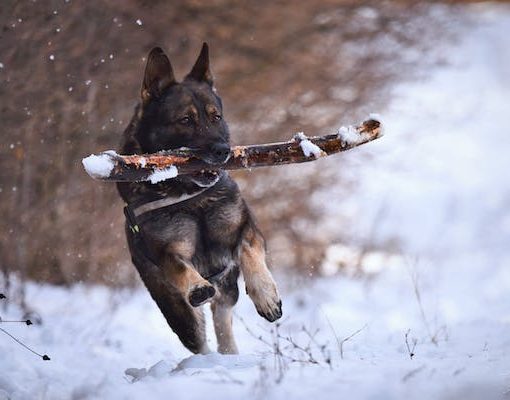Are you wondering why German Shepherds are considered a large and muscular breed but yours is so small? If you do not have any idea what went wrong and would love to see your German Shepherd grow as big as its counterparts.
Then make sure you read this article to the end to find out why and the possible means to make it grow bigger.
Why Is My German Shepherd Still Small After All These Years?
There are 5 reasons why your German Shepherd can be so small. They are;
- Medical Abnormalities
- Heredity
- Intestinal Parasites
- Low-calorie intake
Medical Abnormalities
Gene mutations can cause abnormalities like Dwarfism, which might be the reason why your German Shepherd is still small. You can treat this condition, but it cannot be cured.
Heredity
A German Shepherd who descends from a family with a small size will be naturally small without any underlying health problems.
Intestinal Parasites
Hookworms, tapeworms, or roundworms infestation can lead to worms competing with the German Shepherd for calories, causing stunted growth. These worms are usually contracted from the mother or the environment and can be treated by administering deworming medication.
Poor feeding
Feeding your German Shepherd foods that do not meet its nutritional requirements will make it small and malnourished. German Shepherds are large breeds and as such, require more food to support their growth and development.
Low-calorie intake
German shepherds are high-energy breeds that require adequate calories to support their needs. Therefore, if a German Shepherd is not fed foods that will provide enough calories, it might have stunted growth.
Can German Shepherds Be Small?
Yes, a purebred German Shepherd can be miniature if suffering from a growth disorder called Dwarfism.
How Do I Make My German Shepherd Bigger?
You can make your German Shepherd bigger by;
- Feeding it high-quality meals that are rich in proteins and fats.
- Add dry kibble to your German Shepherd’s diet. It is richer in calories than wet foods.
- Giving it more meals than the regular
- Changing the food you give the adults to a puppy or high-performance foods. These puppy or high-performance foods are rich in calories that will help with healthy weight gain.
Are There Different Sizes Of German Shepherds?
Yes, there are different sizes of German Shepherds. For example, a male German Shepherd with an average adult height of about 24 to 26 inches is bigger than a female, about 22 to 24 inches tall.
How Do I Know If My German Shepherd Has Dwarfism?
You will know if your German Shepherd has Dwarfism if it shows the following signs
- A head that is bigger than normal
- Swollen abdomen
- Abnormal bone structure
- Slow bone development
- Enlarged joints
- Poor or no overall body growth
- A body that is longer than normal
- Legs that are shorter than normal
- Smaller than other littermates
- Bulging eyes
- Skin disorders, including baldness
- Small testicles
- Absence of heat
- Infertility in male and female
- Retention of puppy coat
- Hair loss
- Delayed growth or lack of permanent teeth
- Progressive skin peeling
- Short jaw
- Crooked teeth due to the short jaw
- The tongue sticks out of the mouth
- Very loud puppy bark
- Short nose
- Spinal deformities
- Feet turning outwards
- Bowed front legs
- Breathing difficulty and prolonged panting
- Mentally slower than littermates
Why Is My Dog So Small For Its Breed?
Your dog can be so small for its breed if it is a dwarf, not a pure breed, or it has a very high hookworm or roundworm infestation.
What Dog Looks Like A German Shepherd But Is Smaller?
A Belgian Malinois looks so much like a German Shepherd and can sometimes be mistaken as one, but some differences in their appearance can make you differentiate them.
- A Belgian Malinois has a more petite body than a German Shepherd.
- Its blonde is more pronounced with a black overlay, black mask, and ears.
- A Belgian Malinois has a shorter coat.
Why Is My German Shepherd Not Big?
Your German Shepherd might be a Miniature German Shepherd breed, a mixed breed resulting from crossing a pure German Shepherd with a smaller breed, usually a Collie or a Poodle. The other names for this breed are;
- Mini German Shepherd,
- German Shepherd Border Collie Mix,
- German Shepherd Poodle mix,
- Miniature German Shepherd,
- Mini German Shepherd,
- Mini Shepherd,
- German Shepherd Mix dog,
- The small German Shepherd.
What Age Is A German Shepherd Fully Grown?
A German Shepherd is considered fully grown when it is about 18 months old, meaning 1 year and six months. However, a female German Shepherd will continue growing till it is around 2 years old, while a male German Shepherd will continue growing till it reaches roughly 3 years of age.
Related: Why Are German Shepherds So Clingy?
How Can I Increase The Size Of My Dog?
You can increase the size of your dog by feeding it healthy foods that are high in protein and fat. These foods help your dog to gain more weight.
How Can I Tell If My German Shepherd Is Purebred?
There are 6 different ways to check if your German Shepherd is a pure breed or not. They are;
- Observe the physical features – double coat, muscular build, erected ears, long and hairy tail.
- Observe the behavioral patterns- intelligence and loyalty, clinginess, high energy, and a sense of protection.
- Take a DNA test
- Ask a veterinarian
- Use some dog-scanning apps
- Check the registration certificate
Can You Test Dogs For Dwarfism?
Yes, you can test dogs for Dwarfism using the following methods;
- Physical assessments: checking for weight, height, temperature, pulse, and respiration rates.
- Endocrine tests
- A growth hormone stimulation test: In a dog experiencing Dwarfism, the growth hormone will not increase after stimulating its release with xylazine, clonidine, or GHRH (Growth Hormone Releasing Hormone).
- Insulin Growth Factor Assay: A dog with Dwarfism will have low levels of insulin growth factors.
- Analysis of Hormones: This is done to check the levels of thyroid-stimulating hormones (TSH), follicle-stimulating hormones (FSH), prolactin (PRL), and adrenocorticotropic hormone (ACTH).
Conclusion
A German Shepherd with a small size is a very worrisome issue that needs immediate attention and treatment. But, first, you should find the reasons behind this condition and the possible solutions.
Here in this article, we have provided you with the signs to watch out for, the causes, and the treatments or management practices to adopt for the proper growth of your German Shepherd.





